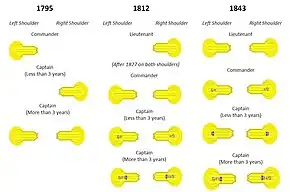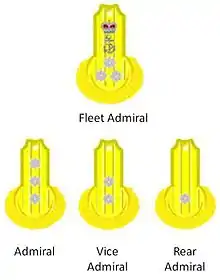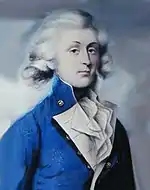 |
| His Majesty's Naval Service of the British Armed Forces |
|---|
| Components |
|
| History and future |
| Ships |
| Personnel |
| Auxiliary services |
These are the official Royal Navy Officer ranks ordered by rank. These ranks are part of the NATO/United Kingdom ranks, including modern and past. Past insignia is in italic.
Rank
| NATO Code | OF-10 | OF-9 | OF-8 | OF-7 | OF-6 | OF-5 | OF-4 | OF-3 | OF-2 | OF-1 | OF(D) | ||
|---|---|---|---|---|---|---|---|---|---|---|---|---|---|
 |
 |
 |
 |
 |
 |
 |
 |
 |
 |
 |
 |
||
| Rank Title: | Admiral of the Fleet[1] | Admiral | Vice admiral | Rear admiral | Commodore | Captain | Commander | Lieutenant commander | Lieutenant | Sub-Lieutenant | Midshipman | Officer Cadet | |
| Abbreviation: | Adm. of the Fleet[nb 1] | Adm | VAdm | RAdm | Cdre | Capt | Cdr | Lt Cdr | Lt | Sub Lt / SLt | Mid | OC | |
Officers


Uniforms for naval officers were not authorised until 1748. At first the cut and style of the uniform differed considerably between ranks, and specific rank insignia were only sporadically used. By the 1790s, the Royal Navy's first established uniform regulations had been published.
Ranks could be indicated by embroidery on the cuffs, by arrangement of buttons or, after 1795, on epaulettes. However, there was no consistent system and insignia might differ between uniforms, and were altered several times. Sometimes there was no specific indication of rank at all.
Midshipmen received a white patch on the collar in 1758, the oldest badge still in use today.
The modern system of gold rings on the cuffs originated on 11 April 1856. For the first time these were consistently applied to all blue uniforms.
| Admiral of the fleet | 1+3⁄4in below four 5⁄8in |
| Admiral | 1+3⁄4in below three 5⁄8in |
| Vice admiral | 1+3⁄4in below two 5⁄8in |
| Rear admiral and Commodore 1st class | 1+3⁄4 in below one 5⁄8in |
| Commodore 2nd class | four 5⁄8in |
| Captain | three 1⁄2in |
| Commander | two 1⁄2in |
| Lieutenant | one 1⁄2in |
| Mate | one 1⁄4in braid |
On 16 April 1861, mates were commissioned as sub-lieutenants and lieutenants were divided into those of over eight years seniority and those under. As a result, on 5 September 1861 the lower ranks' rings were changed:
| Commodore 2nd class | 1+3⁄4in |
| Captain | four 1⁄2in |
| Commander | three 1⁄2in |
| Lieutenant, over 8 years | two 1⁄2in |
| Lieutenant, under 8 years | one 1⁄2in |
and on 25 March 1863 to:
| Commodore 2nd class | 1+3⁄4in |
| Captain | four 1⁄2in |
| Commander | three 1⁄2in |
| Lieutenant | two 1⁄2in |
| Sub-lieutenant | one 1⁄2in |
On 30 October 1877, a lieutenant of eight years'/ seniority got an additional half-ring of 3⁄16in, increased to 1⁄4in in 1891, and in 1914 became the new rank of lieutenant commander.
In 1919, the admiral's narrow stripe was reduced to 1⁄2in, but as King George V had not approved the change, the Royal Family continued to wear the wider ring.
In 1931, all the 1⁄2in rings were all increased to 9⁄16in.
The curl was introduced in 1856, but initially only the military (or executive) and navigating (masters) branches wore it.
Other (civil) branches had plain rings, from 1863 with coloured distinction cloth between or below them. Until 1891 officers of the 'civil' branches had single-breasted coats with different arrangements of buttons.
| Branch | Distinction cloth (1863–1955) | Buttons (1832–1891) |
|---|---|---|
| Masters (until 1867) | Light blue | 9 evenly spaced |
| Masters (after 1867) | None | 3 groups of 3 (on double breasted coat) |
| Surgeons | Red | 3 groups of 3 |
| Pursers/accounting | White | 4 groups of 2 |
| Engineering (from 1853) | Purple | 2 groups of 4 |
| Instructors (from 1879) & schoolmasters (from 1917) | Light blue | 9 evenly spaced |
| Shipwrights (from 1918) | Silver grey | |
| Wardmaster (medical assistants) (from 1918) | Maroon till 1951, then salmon-pink | |
| Electrical (from 1918) | Dark green | |
| Ordnance (1918–1950) | Dark blue | |
| Dentists (from 1924) | Orange |
Engineer officers received the curl in 1915 and all other officers in 1918. At the same time they also received other things such as oak leaves on the peaked cap that had formerly been the prerogative of the military branch.
In 1955 it was announced[2] that the distinction cloth worn between the stripes of officers of the non-executive branches of the Royal Navy was to be abolished, except for those who must be clearly recognisable as non-combatant under the Geneva Convention.
The residual use of distinction cloth for non-combatants is therefore:
- Scarlet – medical
- Orange – dental
- Salmon pink – wardmasters (to 1993)
- Silver grey - civilian officers from Royal Corps of Naval Constructors (RCNC)[3]
- Dark green – civilian officers when required to wear uniform[4][lower-alpha 1]
From 1955 to 1993 there was a rank of acting sub-lieutenant, with the same rank insignia as a sub-lieutenant.
Naval pilots in the Fleet Air Arm (and earlier the Royal Naval Air Service) have wings above the curl on the left hand sleeve. Other Fleet Air Arm officers had a letter 'A' inside the curl.
From 1795 rank badges could also be shown on epaulettes. The system changed several times, but after 1864 was as follows:
| Admiral of the fleet | Crown, crossed batons, and four stars |
| Admiral | Crown, crossed baton & sword, and three stars |
| Vice admiral | Crown, crossed baton & sword, and two stars |
| Rear admiral | Crown, crossed baton & sword, and one (larger) star |
| Commodore & captain over three years | Crown, two stars, and foul anchor |
| Captain under 3 years | Crown, one star, and foul anchor |
| Commander | Crown and foul anchor |
| Lieutenant over eight years after 1914 Lieutenant commander | Star and foul anchor |
| Lieutenant under 8 years | Foul anchor |
Sub-lieutenants and commissioned warrant officers wore scales (epaulettes without fringes, officially termed "shoulder straps") and the same device as a lieutenant.
Epaulettes of the military branch were gold throughout with silver devices, while those of the civil branches had a silver edging and gold devices. Instead of the baton and sword or foul anchor, civil branch epaulettes substituted a star. Navigating branch epaulettes were the same as the military branch, but with crossed plain anchors in place of the foul anchor. The epaulette stars had eight points, quite unlike the Order of the Bath stars worn by army officers.[lower-alpha 2]
In 1891 the admiral of the fleet changed to a crown above two crossed batons within a wreath, similar to the badge of a field marshal.
Also in 1891 shoulder-straps were introduced for use on white uniforms and on the greatcoat, and more recently in "shirt sleeve order". For these commodores first class and above used the same badge as on their epaulettes, and commodores second class and below used their rank rings.
From 1926 only commodores had two stars, other captains one.
Epaulettes were not worn after 1939.
In 2001,[lower-alpha 3] the shoulder boards on dress uniforms were changed and are currently:
| Admiral of the fleet | Crown, 2 crossed batons within a wreath |
| Admiral | Crown, crossed baton & sword and 4 stars |
| Vice admiral | Crown, crossed baton & sword and 3 stars |
| Rear admiral | Crown, crossed baton & sword and 2 stars |
| Commodore | Crown, crossed baton & sword and 1 star |
| Captain | Crown, one star, and foul anchor |
| Commander | Crown and foul anchor |
Historical insignia
| Rank group | Flag officers | Senior officers | Junior officers | |||||||||
|---|---|---|---|---|---|---|---|---|---|---|---|---|
| 1856–1861 |  |
 |
 |
 |
 |
 |
 |
 |
 |
 |
||
| Admiral of the fleet | Admiral | Vice admiral | Rear admiral | Commodore 1st class | Commodore 2nd class | Captain | Commander | Lieutenant | Mate | |||
| 1861–1863 | ||||||||||||
Warrant officers

Warrant officers first received their uniforms in 1787. The navigators, surgeons and pursers were commissioned in 1843 and their insignia are described above.
In 1865 chief (later commissioned) gunners, boatswains, and carpenters were given a single 1⁄2in ring, with the curl, though the carpenters lost the curl in 1879.
In 1891 ordinary warrant officers of 10 years' standing were given a half-ring of 1⁄4in, with or without curl as above.
In 1918 this ring, with the curl, was extended to all non-commissioned warrant officers.
In 1949 WOs and CWOs became "commissioned branch officers" and "senior commissioned branch officers" and were admitted to the wardroom, but their insignia remained the same.
In 1956 they were integrated into the line officers as sub-lieutenants and lieutenants, and class distinctions finally disappeared from the uniform.
Reserves
From 1863 officers were commissioned in the Royal Naval Reserve this was for serving merchant navy officers only. They had rings each formed from two 1⁄4 inch wavy lines intersecting each other. The curl was formed into a six-pointed star. The lieutenant commander's half-ring was straight, but only 1⁄8 inch wide. The commodore had a broad straight ring, but the same star for a curl. Midshipmen had a blue collar patch.
Officers of the Royal Naval Volunteer Reserve (formed 1903) for civilians, had single wavy rings 1⁄4 inch wide, with the curl a squarish shape. The lieutenant commander's narrow ring was originally straight, but after 1942 was waved also. This system of rank insignia is still worn today by officers in the Sea Cadets. Midshipmen in the RNVR had a maroon collar patch.
In 1951 both reserves lost their distinctive insignia and got normal straight stripes like the regulars, but with a letter 'R' inside the curl. The two organisations were merged in 1958. In 2007 officers of the Royal Naval Reserve had the 'R' distinction from badges of rank removed. Honorary officers in the RNR however continue to wear the 'R' inside the curl.
| Rank group | General / flag officers | Senior officers | Junior officers | Officer cadet | ||||||||||||||||||||||||||||||||
|---|---|---|---|---|---|---|---|---|---|---|---|---|---|---|---|---|---|---|---|---|---|---|---|---|---|---|---|---|---|---|---|---|---|---|---|---|
(1916-1951) |
_1916-1951.png.webp) |
_1916-1951.png.webp) |
_1916-1951.png.webp) |
_1916-1951.png.webp) |
_1916-1951.png.webp) |
_1916-1951.png.webp) |
 |
 |
||||||||||||||||||||||||||||
| Commodore | Captain | Commander | Lieutenant commander | Lieutenant | Sub lieutenant | Midshipman | Naval Cadet | |||||||||||||||||||||||||||||
(1916-1941) |
_1916-1958.png.webp) |
 |
 |
 |
 |
 |
 |
 |
||||||||||||||||||||||||||||
| Commodore | Captain | Commander | Lieutenant commander | Lieutenant | Sub lieutenant | Midshipman | Naval Cadet | |||||||||||||||||||||||||||||
(1942-1951) |
_1916-1958.png.webp) |
 |
 |
 |
 |
 |
 |
 |
||||||||||||||||||||||||||||
| Commodore | Captain | Commander | Lieutenant commander | Lieutenant | Sub lieutenant | Midshipman | Naval Cadet | |||||||||||||||||||||||||||||
(1952-2006) |
 |
 |
 |
 |
 |
 |
 |
|||||||||||||||||||||||||||||
| Commodore | Captain | Commander | Lieutenant commander | Lieutenant | Sub lieutenant | Midshipman | Naval Cadet | |||||||||||||||||||||||||||||
| NATO code | OF-10 | OF-9 | OF-8 | OF-7 | OF-6 | OF-5 | OF-4 | OF-3 | OF-2 | OF-1 | OF(D) | Student officer | ||||||||||||||||||||||||
Wrens
Officers in the Women's Royal Naval Service had straight rings in light blue, with a diamond shape instead of the curl. The Women's Royal Naval Service was abolished in 1994 and female officers now have the same gold rings as male officers.
Royal Marines
| NATO Code | OF-10 | OF-9 | OF-8 | OF-7 | OF-6 | OF-5 | OF-4 | OF-3 | OF-2 | OF-1 | OF(D) | |
|---|---|---|---|---|---|---|---|---|---|---|---|---|
 |
 |
 |
 |
 |
 |
 |
 |
 |
 |
 |
.svg.png.webp) | |
| Rank title: | Captain General Royal Marines | General | Lieutenant-general | Major-general | Brigadier | Colonel | Lieutenant colonel | Major | Captain | Lieutenant | Second lieutenant | Officer cadet |
Part of the RN as the Senior Service, the Royal Marines uses the same rank structure and insignia that the British Army has, save for the field marshal rank, and the RM initials for second lieutenants to lieutenant colonels to distinguish them from the Army itself. The major general rank since 1996 is the highest rank of the officer corps, but in the past, generals and lieutenant generals headed the Corps, and from 1857 to 1957 the Corps also had the unique ranks of colonel second commandant and colonel commandant. Rank insignia are on brown or dark blue shoulder boards in all dresses save for the combat and barracks duty dress uniforms. From 1911 to 1957 the officer corps even included warrant officers and commissioned warrant officers in the same way as the RN. Although the Royal Marines does not officially use the rank of field marshal, the Captain General Royal Marines, the ceremonial head of the corps, wears a field marshal's rank insignia.[5]
Officer ranks of the Royal Marines
Historical ranks in italic.
- Warrant officer
- Commissioned warrant officer
- Probationary second lieutenant
- Probationary lieutenant
- Ensign
- Second lieutenant
- Lieutenant
- Captain lieutenant
- Second captain
- Captain
- Junior major
- Senior major
- Major
- Lieutenant colonel
- Colonel
- Colonel second commandant
- Colonel commandant - replaced by 1957 with brigadier
- Brigadier - acting rank, an appointment for colonels. until 1997
- Brigadier general - temporary appointment rather than substantive rank. used from 1913 to 1921
- Major general
- Lieutenant general
- General
See also
Notes
- ↑ The requirement for civilian officers to wear uniform – refer BRd 81 – normally arises when deployed overseas, including periods of duty exceeding 24 hours when embarked on a UK or allied vessel operating outside UK territorial waters.
- ↑ Order of the Bath stars worn by army officers have four points and are sometimes referred to as "pips".
- ↑ Refer UK Defence Council Instruction (Joint Service) (DCI(JS)) 125/2001
- ↑ The rank of Admiral of the Fleet has become an honorary/posthumous rank, war time rank; ceremonial rank; regular appointments ended in 1995.
References
Citations
- ↑ Shown with cipher of Elizabeth II
- ↑ "Statement of the First Lord of the Admiralty (Mr. J. P. L. Thomas)", Parliamentary Debates (Hansard), vol. 537, cc2247-301, 3 March 1955
- ↑ "BR3 Volume 1 - Naval Personnel Management, Chapter 46, (Version 6), para 4603" (PDF). Royal Navy. June 2016.
- ↑ "BR3 Volume 1 - Naval Personnel Management, Chapter 39, (Version 6), para 3912" (PDF). Royal Navy. June 2016.
- ↑ "HRH Prince Philip lends support to the Royal Marines Charity with final official engagement". Royal Marines Charity. 27 July 2017. Retrieved 20 December 2017.
Sources
- May, W.E.; Carman, W.Y.; Tanner, John (1974). Badges and Insignia of the British Armed Services. Adam & Charles Black. ISBN 0-7136-1344-0.
- BRd 81 "Naval Service - Uniform Regulations". UK Ministry of Defence. May 2009 [November 2005].
- Coleman, E. C. (2009). Rank and Rate - Royal Naval Officers' Insignia Since 1856. Marlborough: The Crowood Press Ltd.
- Coleman, E. C. (2011). Rank and Rate Volume II: Insignia of Royal Naval Ratings, WRNS, Royal Marines, QARNNS and Auxiliaries. Marlborough: The Crowood Press Ltd.
- Rodger, N.A.M (2011). "Commissioned officers' careers in the Royal Navy, 1690–1815". Journal for Maritime Research. 3 (1): 85–129. doi:10.1080/21533369.2001.9668314. S2CID 163008417.